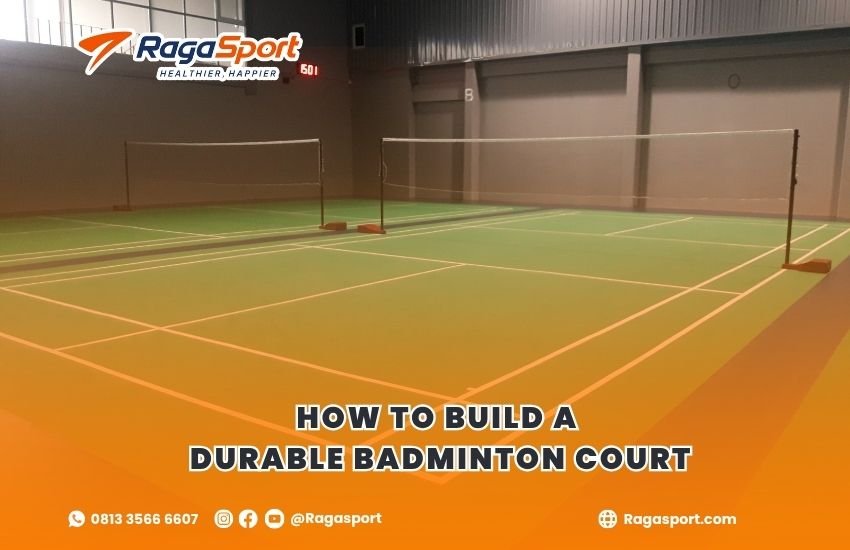Building a badminton court that lasts is more than pouring concrete and painting lines. It’s about crafting a space that can withstand thousands of shuttlecock smashes, dynamic footwork, and years of intense play—whether under a roof or open sky. This guide breaks down the essentials of building a durable badminton court from scratch, combining technical know-how with practical advice rooted in real construction experience.
Table of Contents
1. Site Selection: Where Your Court’s Lifespan Begins
Before a single tool hits the ground, the location sets the tone for everything else. A poorly chosen site can compromise drainage, surface stability, and long-term performance.
Outdoor Considerations:
- Choose a level terrain with natural water runoff.
- Avoid low-lying areas where water accumulates.
- Opt for locations away from tree lines to prevent debris and root invasion.
Indoor Criteria:
- Minimum height clearance of 9 meters is a must.
- Look for well-ventilated structures with capacity for even lighting distribution.
- Ensure space allows for unobstructed court boundaries and spectator areas, if needed.
A durable court begins where the earth and environment are most stable.
2. Court Dimensions: Precision Before Paint
Badminton isn’t a guessing game—and neither is its layout. The court must adhere to official Badminton World Federation (BWF) standards:
- 13.4 m (Length)
- 6.1 m (Width for doubles)
- 5.18 m (Width for singles)
- Short service line: 1.98 m from the net
Precision in layout prevents gameplay issues and ensures the surface will wear evenly over time.
3. Build from the Ground Up: Base Construction

Durability is built in layers, starting with what you can’t see.
For Outdoor Courts:
- Start with a compacted subgrade followed by crushed gravel to support drainage.
- Lay a concrete slab of 100–150 mm thickness, reinforced with steel mesh.
- Ensure a slight slope (1%) for water runoff.
For Indoor Courts:
- Use moisture barriers beneath a reinforced concrete slab.
- Floor must be perfectly leveled to support synthetic or wooden systems.
Every layer should be compacted, leveled, and tested—never rush this stage. A strong base is your court’s insurance policy.
4. Surface Selection: The Heart of Performance
This is where play meets practicality. The court surface should balance comfort, grip, and durability depending on the court type.
Vinyl or PU Flooring (Indoor):
- Ideal for pro-level games and tournaments.
- Shock-absorbing, anti-slip, and low-maintenance.
- Installed in rolls or tiles on a perfectly dry, clean concrete base.
Engineered Wood (Indoor):
- Preferred for high-performance indoor arenas.
- Must be treated for humidity resistance.
- Requires regular re-finishing and controlled environments.
Acrylic Coating (Outdoor):
- Popular for clubs and community courts.
- UV-resistant, weatherproof, and budget-friendly.
- Should be recoated every few years to maintain surface grip.
Avoid cheap alternatives. They crack, fade, and fail fast.
5. Drainage & Moisture: The Silent Court Killer

Water is your court’s worst enemy—outdoor or indoor. Without proper drainage, cracks form, mold grows, and the surface fails prematurely.
Drainage Must-Haves:
- Outdoor: Install perimeter drains and ensure base slope.
- Indoor: Use vapor barriers, dehumidifiers, and climate control systems.
- Seal concrete to resist rising dampness and chemical erosion.
Drainage might not be visible, but its absence becomes painfully obvious over time.
6. Equipment That Endures
What’s a great surface without great gear?
- Posts: Use rust-proof aluminum or stainless steel, anchored with precision.
- Net: Regulation height is 1.55 m at the sides and 1.524 m at the center.
- Lighting (Indoor): Use LED systems with anti-glare diffusers, mounted 7+ meters high.
- Fencing (Outdoor): Chain-link or mesh fencing keeps the play contained and the environment safe.
Investing in premium equipment saves long-term costs and boosts your facility’s credibility.
7. Marking Lines with Professional Finish

Court markings are not mere aesthetics—they’re part of the game mechanics.
- Use high-contrast, anti-skid acrylic or PU paint.
- Apply using laser guides or stencils to ensure precision.
- Allow proper curing time before first use.
Durable markings reduce the need for frequent touch-ups and enhance visual clarity during gameplay.
8. Ongoing Maintenance: Your Court’s Lifespan Multiplier
Even the most robust courts need care.
Monthly:
- Sweep or mop debris, dust, and leaves.
- Check for loose posts, net tension, or surface damage.
Yearly:
- Resurface or repaint faded lines.
- Sand and re-seal wooden floors.
- Reseal cracks before they expand.
Maintenance is not an expense—it’s a safeguard for your investment.
9. Construction Timeline & Budget Insight
A high-quality badminton court takes time to build right.
- Outdoor court (acrylic): IDR 150–250 million
- Indoor court (vinyl or wood): IDR 300–500 million
- Construction time: 4–8 weeks depending on size, weather, and material lead times
Cost varies by location, materials, and optional features like lighting or fencing.
10. Why You Need a Trusted Court Builder
DIY or working with general contractors might seem cheaper—but sports facility construction is a niche expertise.
A professional builder ensures:
- Adherence to BWF standards
- Long-lasting, quality-assured materials
- Skilled workmanship and precise layout
- Guaranteed timelines and after-service care
Avoid costly mistakes by working with people who’ve built hundreds of courts—not just concrete slabs.
Ready to Build the Perfect Badminton Court?

Let Raga Sport turn your vision into reality with expert construction, top-quality materials, and a court that meets every standard.
👉 Explore our projects at https://ragasport.com/badminton-court-construction-services/
📲 Chat with our team now via WhatsApp: wa.me/6281335666607

